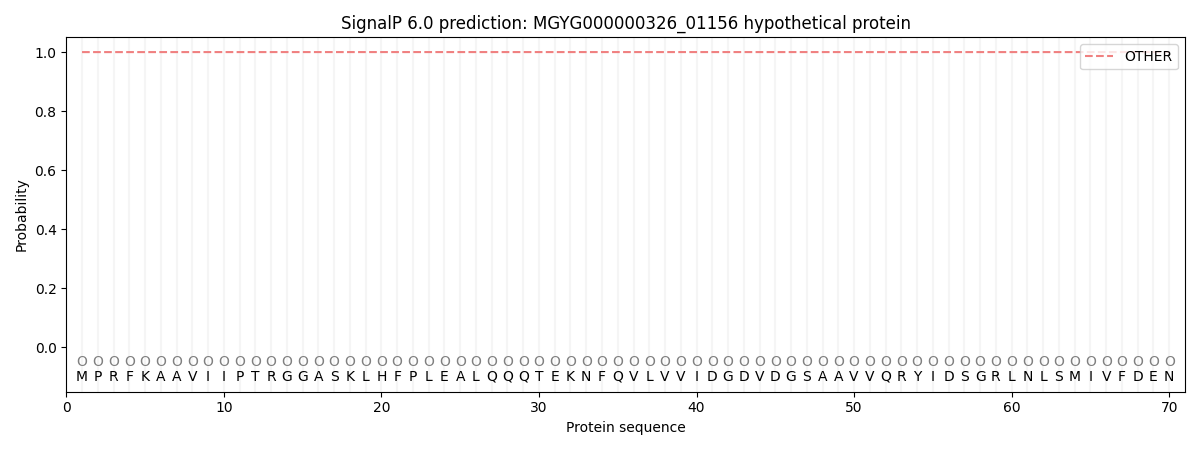You are browsing environment: HUMAN GUT
CAZyme Information: MGYG000000326_01156
You are here: Home > Sequence: MGYG000000326_01156
Basic Information |
Genomic context |
Full Sequence |
Enzyme annotations |
CAZy signature domains |
CDD domains |
CAZyme hits |
PDB hits |
Swiss-Prot hits |
SignalP and Lipop annotations |
TMHMM annotations
Basic Information help
| Species | Rothia terrae | |||||||||||
|---|---|---|---|---|---|---|---|---|---|---|---|---|
| Lineage | Bacteria; Actinobacteriota; Actinomycetia; Actinomycetales; Micrococcaceae; Rothia; Rothia terrae | |||||||||||
| CAZyme ID | MGYG000000326_01156 | |||||||||||
| CAZy Family | GT2 | |||||||||||
| CAZyme Description | hypothetical protein | |||||||||||
| CAZyme Property |
|
|||||||||||
| Genome Property |
|
|||||||||||
| Gene Location | Start: 8644; End: 9588 Strand: - | |||||||||||
CAZyme Signature Domains help
| Family | Start | End | Evalue | family coverage |
|---|---|---|---|---|
| GT2 | 8 | 157 | 1e-21 | 0.8823529411764706 |
CDD Domains download full data without filtering help
| Cdd ID | Domain | E-Value | qStart | qEnd | sStart | sEnd | Domain Description |
|---|---|---|---|---|---|---|---|
| cd00761 | Glyco_tranf_GTA_type | 1.86e-21 | 8 | 110 | 1 | 102 | Glycosyltransferase family A (GT-A) includes diverse families of glycosyl transferases with a common GT-A type structural fold. Glycosyltransferases (GTs) are enzymes that synthesize oligosaccharides, polysaccharides, and glycoconjugates by transferring the sugar moiety from an activated nucleotide-sugar donor to an acceptor molecule, which may be a growing oligosaccharide, a lipid, or a protein. Based on the stereochemistry of the donor and acceptor molecules, GTs are classified as either retaining or inverting enzymes. To date, all GT structures adopt one of two possible folds, termed GT-A fold and GT-B fold. This hierarchy includes diverse families of glycosyl transferases with a common GT-A type structural fold, which has two tightly associated beta/alpha/beta domains that tend to form a continuous central sheet of at least eight beta-strands. The majority of the proteins in this superfamily are Glycosyltransferase family 2 (GT-2) proteins. But it also includes families GT-43, GT-6, GT-8, GT13 and GT-7; which are evolutionarily related to GT-2 and share structure similarities. |
| COG1216 | GT2 | 4.00e-20 | 5 | 239 | 4 | 247 | Glycosyltransferase, GT2 family [Carbohydrate transport and metabolism]. |
| pfam00535 | Glycos_transf_2 | 3.34e-18 | 8 | 133 | 2 | 126 | Glycosyl transferase family 2. Diverse family, transferring sugar from UDP-glucose, UDP-N-acetyl- galactosamine, GDP-mannose or CDP-abequose, to a range of substrates including cellulose, dolichol phosphate and teichoic acids. |
| cd04186 | GT_2_like_c | 8.62e-17 | 8 | 212 | 1 | 165 | Subfamily of Glycosyltransferase Family GT2 of unknown function. GT-2 includes diverse families of glycosyltransferases with a common GT-A type structural fold, which has two tightly associated beta/alpha/beta domains that tend to form a continuous central sheet of at least eight beta-strands. These are enzymes that catalyze the transfer of sugar moieties from activated donor molecules to specific acceptor molecules, forming glycosidic bonds. Glycosyltransferases have been classified into more than 90 distinct sequence based families. |
| cd06423 | CESA_like | 2.29e-15 | 8 | 178 | 1 | 174 | CESA_like is the cellulose synthase superfamily. The cellulose synthase (CESA) superfamily includes a wide variety of glycosyltransferase family 2 enzymes that share the common characteristic of catalyzing the elongation of polysaccharide chains. The members include cellulose synthase catalytic subunit, chitin synthase, glucan biosynthesis protein and other families of CESA-like proteins. Cellulose synthase catalyzes the polymerization reaction of cellulose, an aggregate of unbranched polymers of beta-1,4-linked glucose residues in plants, most algae, some bacteria and fungi, and even some animals. In bacteria, algae and lower eukaryotes, there is a second unrelated type of cellulose synthase (Type II), which produces acylated cellulose, a derivative of cellulose. Chitin synthase catalyzes the incorporation of GlcNAc from substrate UDP-GlcNAc into chitin, which is a linear homopolymer of beta-(1,4)-linked GlcNAc residues and Glucan Biosynthesis protein catalyzes the elongation of beta-1,2 polyglucose chains of Glucan. |
CAZyme Hits help
| Hit ID | E-Value | Query Start | Query End | Hit Start | Hit End |
|---|---|---|---|---|---|
| QNV37335.1 | 4.23e-218 | 1 | 314 | 1 | 314 |
| QNV41053.1 | 3.61e-143 | 1 | 314 | 1 | 315 |
| QRZ61195.1 | 8.74e-132 | 4 | 314 | 3 | 314 |
| QXW98968.1 | 1.14e-127 | 3 | 314 | 6 | 315 |
| BAS19628.1 | 5.35e-126 | 3 | 314 | 6 | 315 |
Swiss-Prot Hits download full data without filtering help
| Hit ID | E-Value | Query Start | Query End | Hit Start | Hit End | Description |
|---|---|---|---|---|---|---|
| H2K893 | 3.45e-18 | 7 | 204 | 12 | 234 | Validoxylamine A glucosyltransferase OS=Streptomyces hygroscopicus subsp. jinggangensis (strain 5008) OX=1133850 GN=valG PE=1 SV=1 |
| Q15JF5 | 2.46e-17 | 7 | 204 | 43 | 265 | Validoxylamine A glucosyltransferase OS=Streptomyces hygroscopicus subsp. limoneus OX=264445 GN=vldK PE=3 SV=1 |
| O06483 | 2.70e-09 | 5 | 211 | 2 | 253 | Uncharacterized glycosyltransferase YfnE OS=Bacillus subtilis (strain 168) OX=224308 GN=yfnE PE=3 SV=2 |
| Q68X33 | 2.91e-08 | 7 | 178 | 11 | 179 | Uncharacterized glycosyltransferase RT0329 OS=Rickettsia typhi (strain ATCC VR-144 / Wilmington) OX=257363 GN=RT0329 PE=3 SV=1 |
| Q9ZDI9 | 1.26e-07 | 7 | 178 | 11 | 179 | Uncharacterized glycosyltransferase RP339 OS=Rickettsia prowazekii (strain Madrid E) OX=272947 GN=RP339 PE=3 SV=1 |
SignalP and Lipop Annotations help
This protein is predicted as OTHER

| Other | SP_Sec_SPI | LIPO_Sec_SPII | TAT_Tat_SPI | TATLIP_Sec_SPII | PILIN_Sec_SPIII |
|---|---|---|---|---|---|
| 1.000064 | 0.000000 | 0.000000 | 0.000000 | 0.000000 | 0.000000 |
